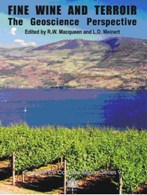Fine Wine and Terroir: The geoscience perspective
Geoscience Canada Reprint Series 9

R W Macqueen & L D Meinert (eds)
Published by: The Geological Association of Canada
Publication date: 2006
ISBN: 1-897095-21-X
List price: CDN $49.95 (GAC Member price: CDN $37.46)
266 pp
www.gac.ca
The validity of the concept of ‘Terroir’ has been disputed for a number of years among geoviticulturalists and wine makers. For many European vignerons the concept of ‘Terroir’ has been used in the same way as a drunk uses a lamppost, more for support than illumination. A leading ‘anti-terroiriste’, the late great geoviticulturalist Jake Hancock opined that ‘Terroir’ was nothing more than a combination of second-rate science and medieval mysticism (Hancock, 1999). Many winemakers from the New World share Professor Hancock’s cynicism. Indeed when this reviewer once asked an Australian wine maker what impact geology had on wine his reply was unprintable. Moran (1988) went so far as to argue that the concept of ‘Terroir’ is just another way of hiking up the price of land. Fine Wine and Terroir showcases the present thinking of North American geoviticulturalists on the ‘Terroir’ concept.
The book is dedicated to the memory of the late Simon J Haynes, one of Canada’s leading geoviticulturalists. Over a period of seven years Haynes commissioned a series of articles on geology and wine for Geoscience Canada. These are reprinted in this volume, together with three articles by Haynes, six new papers, a Dedication by Macqueen and an Introduction by Meinert. Haynes’ papers set the scene, expounding his views on ‘Terroir’. Haynes defines ‘Terroir’ as ‘that specific quality of a wine produced from a particular grape variety at the micro-level of a vineyard.’ He goes on to write that ‘Terroir is a fundament (sic) of the complex interrelationship of all the factors above and below ground that affect the grape during growth, excluding pests, diseases, herbicides, mutations, etc..’. Haynes lists these factors as meteorology, physiography, pedology, geology and viticulture. Several authors, notably Wilson, offer their own definitions of ‘Terroir’ in their papers. They all follow, with minor differences, Haynes’ definition quoted above.
Most of the papers in this volume discuss the interplay of geology, climate and viticulture in various winelands. Geographically they cover California, Idaho, Oregon and Washington in the USA, and Ontario and British Columbia in Canada. There are also single papers on Italy and the Cape Province of South Africa. These two contributions usefully provide a wider perspective. Greg Jones contributes a valuable paper on the impact of climate change on viticulture. Two papers discuss the application of GIS to understanding ‘Terroir’. Most interestingly, Bowen et al attempt a level of objectivity by analysing the correlation between medal winning wines and soil types. The validity of the concept of ‘Terroir’ is implicit in most contributions to the volume, but words such as ‘mystery’, ‘religious belief’ and ‘matter of faith’ abound throughout the book, and will set sceptical scientists’ antennae aquiver. A contribution by a New World ‘anti-terroiriste’ would have given this book better balance. Nonetheless Fine Wine and Terroir is essential reading for any geologist interested in the relationship between rocks and wine.
The text is interspersed with tables and plenty of good quality illustrations, many in colour. There is no index, but the Introduction by Meinert provides a useful route map for readers opening the book for the first time. Francophone readers will be grateful for the French abstracts.
Dick Selley